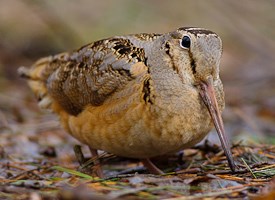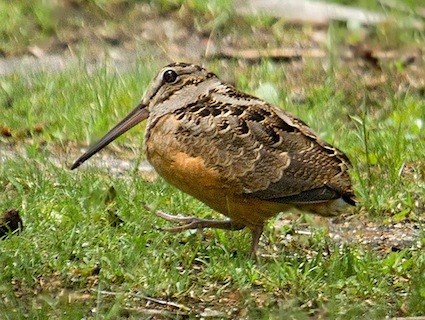reposted from
 IUCN Conservation Status: Least Concern
IUCN Conservation Status: Least Concern

Shorebirdlike
American Woodcock
Scolopax minor ORDER: CHARADRIIFORMES FAMILY: SCOLOPACIDAE
 IUCN Conservation Status: Least Concern
IUCN Conservation Status: Least Concern
Superbly camouflaged against the leaf litter, the brown-mottled American Woodcock walks slowly along the forest floor, probing the soil with its long bill in search of earthworms. Unlike its coastal relatives, this plump little shorebird lives in young forests and shrubby old fields across eastern North America. Its cryptic plumage and low-profile behavior make it hard to find except in the springtime at dawn or dusk, when the males show off for females by giving loud, nasalpeent calls and performing dazzling aerial displays.
Keys to identification

Shorebirdlike
Typical Voice
Size & Shape
American Woodcocks are plump, short-legged shorebirds with very long, straight bills. Their large heads, short necks, and short tails give them a bulbous look on the ground and in flight. The wings are broad and rounded compared to most other shorebirds.Color Pattern
They are well camouflaged in light brown, black, buff, and gray-brown tones. The face is buffy, the crown blackish. They are light gray across the neck and back, with dark-and-light patterned shoulders and brown wings. The underparts are buffy to almost orange.Behavior
American Woodcock spend most of their time hidden in fields and on the forest floor, where they probe for earthworms. On spring nights, males perform very conspicuous displays, giving a buzzy peent call, then launching into the air. Their erratic display flight includes a distinctive, twittering flight sound and ends with a steep dive back to the ground.Habitat
Look for American Woodcock in forests, forest edges, old fields, and wet meadows of eastern North America.








No comments:
Post a Comment